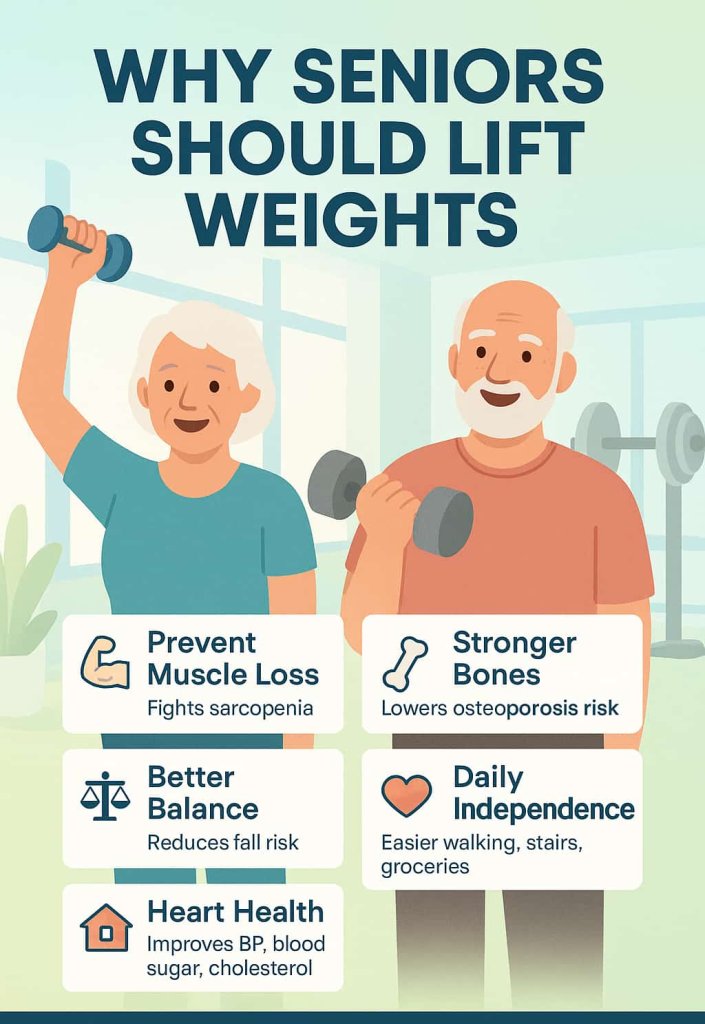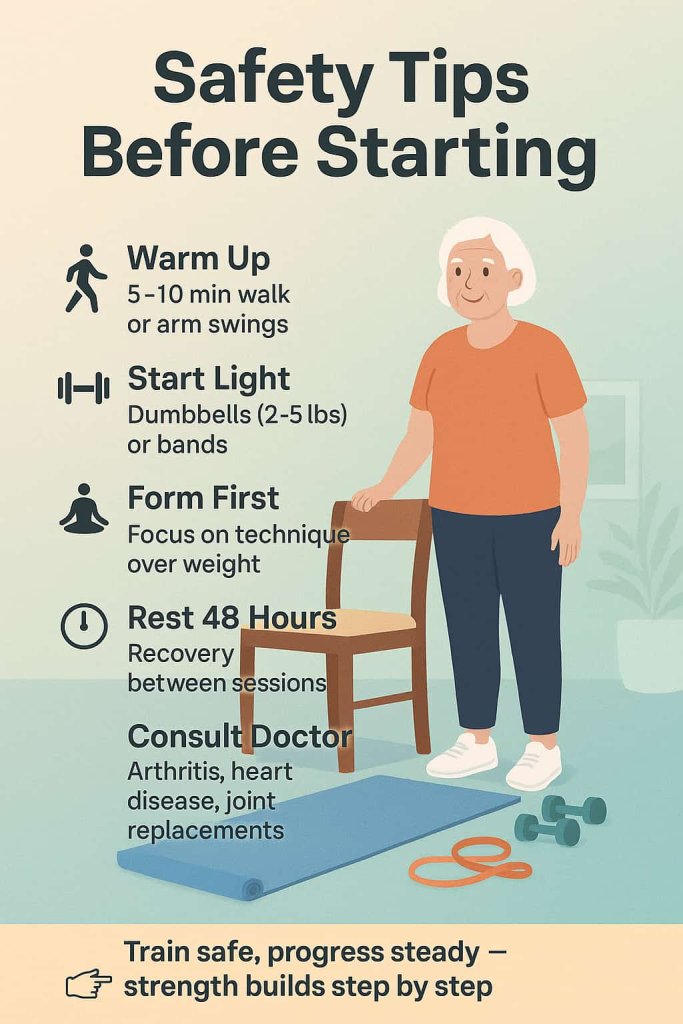Yes, seniors over 60 can safely lift weights—and it’s one of the best ways to stay strong, mobile, and independent.

Weight lifting helps older adults fight muscle loss, improve bone density, reduce fall risk, and boost heart health. According to the National Institute on Aging (2024), strength training not only builds muscle but also improves balance, mobility, and independence in daily life.
In this guide, you’ll learn the 12 best weight lifting exercises for seniors, safety tips, benefits, and how to get started. Each exercise is senior-friendly, functional, and can be done at home or the gym.
Why Seniors Should Lift Weights

- Prevent muscle loss (sarcopenia): Without training, adults lose 3–8% of muscle per decade after 30.
- Stronger bones: Weight-bearing exercise reduces osteoporosis risk.
- Better balance & fewer falls: Strong legs and core protect mobility.
- Heart & metabolic health: Improves blood pressure, blood sugar, and cholesterol.
- Daily independence: Easier walking, climbing stairs, and carrying groceries.
👉 A UCLA Health (2024) study found that even heavier resistance training (when performed correctly) can be safe and highly effective for older adults.
Safety Tips Before Starting

- Warm up 5–10 minutes with light walking or arm swings.
- Start with light dumbbells (2–5 lbs) or resistance bands.
- Focus on form over weight.
- Rest 48 hours between weight sessions.
- Consult your doctor if you have arthritis, heart disease, or joint replacements.
12 Best Weight Lifting Exercises for Seniors
Weight lifting is one of the safest and most effective ways for seniors to stay strong, mobile, and independent after 60. With the right exercises, you can protect your joints, improve balance, and maintain muscle mass for daily activities like climbing stairs, carrying groceries, or getting up from a chair.
Below are 12 of the best senior-friendly weight lifting exercises, including their benefits, muscles worked, and safe step-by-step instructions.
1. Chair Squats (Sit-to-Stand)
Muscles worked: Quadriceps, glutes, hamstrings
Why it helps: Builds strength for everyday tasks like sitting, standing, and stair climbing.
How to do it:
- Sit on a sturdy chair with feet flat on the floor.
- Cross your arms over your chest.
- Push through your heels to slowly stand up tall.
- Lower back down with control.
Trainer Tip: If needed, use your hands on the chair or armrests for support. Over time, progress to bodyweight squats without the chair.
2. Dumbbell Deadlift (Hip Hinge Variation)
Muscles worked: Glutes, hamstrings, lower back
Why it helps: Trains safe lifting technique, protecting your back when picking up groceries or household items.
How to do it:
- Stand with feet hip-width apart, holding light dumbbells in front of thighs.
- Hinge at the hips, keeping back straight and knees slightly bent.
- Lower weights to knee height, then return to standing.
Trainer Tip: Focus on bending at the hips, not rounding your back. Start with no weights until you master form.
3. Seated Overhead Press
Muscles worked: Shoulders, triceps, core
Why it helps: Improves reach and overhead strength for lifting items into cupboards.
How to do it:
- Sit tall on a sturdy chair with a dumbbell in each hand.
- Start with arms bent, weights at shoulder height.
- Press arms overhead until elbows are straight.
- Lower slowly to start position.
Trainer Tip: Keep your back supported and use light weights (2–5 lbs) to avoid strain.
4. Bicep Curls
Muscles worked: Biceps
Why it helps: Makes carrying groceries, lifting bags, and other pulling tasks easier.
How to do it:
- Hold dumbbells at your sides, palms facing forward.
- Bend elbows and curl the weights toward your shoulders.
- Lower slowly with control.
Trainer Tip: Keep elbows close to your body to avoid swinging.
5. Tricep Extensions (Seated or Standing)
Muscles worked: Triceps
Why it helps: Strengthens the arms for pushing motions like closing doors or pushing up from a chair.
How to do it:
- Hold one or two dumbbells overhead.
- Bend elbows, lowering the weight behind your head.
- Straighten arms back up.
Trainer Tip: Keep elbows close to your ears. If overhead movement is uncomfortable, try a kickback variation instead.
6. Step-Ups (Bodyweight or Dumbbells)
Muscles worked: Quadriceps, glutes, calves
Why it helps: Improves balance, coordination, and stair-climbing ability.
How to do it:
- Stand in front of a low step or sturdy stair.
- Step up with one leg, then bring the other up.
- Step down carefully and repeat.
Trainer Tip: Use a railing or wall for balance. Start with a low step height.
7. Dumbbell Chest Press
Muscles worked: Chest, shoulders, triceps
Why it helps: Strengthens pushing motions like opening doors and getting up from the floor.
How to do it:
- Lie on a bench, mat, or floor with dumbbells in hand.
- Start with arms bent, elbows out to the sides.
- Press dumbbells upward until arms are straight.
- Lower slowly to chest level.
Trainer Tip: Use light weights and avoid locking elbows.
8. Dumbbell Rows
Muscles worked: Upper back, lats, biceps
Why it helps: Supports posture, reduces rounded shoulders, and improves pulling strength.
How to do it:
- Place left hand on a chair or bench for support.
- Hold a dumbbell in the right hand, arm hanging down.
- Pull the dumbbell toward your waist, keeping elbow close to body.
- Lower slowly. Repeat other side.
Trainer Tip: Keep your back flat and core tight throughout.
9. Lateral Arm Raises
Muscles worked: Shoulders, upper back
Why it helps: Improves shoulder mobility and strength for reaching and lifting.
How to do it:
- Hold light dumbbells (1–3 lbs) at your sides.
- Raise arms out to the sides until shoulder height.
- Lower slowly.
Trainer Tip: Avoid heavy weights; focus on control and smooth movement.
10. Calf Raises (With Dumbbells Optional)
Muscles worked: Calves, ankles
Why it helps: Strengthens ankles and improves balance for walking and fall prevention.
How to do it:
- Stand tall with feet hip-width apart.
- Hold a chair for support if needed.
- Rise onto your toes, hold for 2–3 seconds, then lower slowly.
Trainer Tip: Try progressing to single-leg calf raises when ready.
11. Farmer’s Carry
Muscles worked: Grip, shoulders, core, legs
Why it helps: Builds functional strength for carrying groceries, luggage, or household items.
How to do it:
- Hold a dumbbell in each hand at your sides.
- Stand tall with shoulders back and core engaged.
- Walk slowly for 20–30 steps, then rest.
Trainer Tip: Use light weights at first and focus on posture.
12. Plank (Bodyweight or Modified)
Muscles worked: Core, shoulders, arms
Why it helps: Improves stability, posture, and reduces fall risk.
How to do it:
- Start with wall planks: Stand facing a wall, place forearms against it, and lean forward.
- Progress to incline planks on a countertop or sturdy bench.
- Hold 10–20 seconds, gradually increasing time.
Trainer Tip: Keep back straight and avoid holding your breath.
How Often Should Seniors Lift Weights?
- Frequency: 2–3 sessions per week (non-consecutive days).
- Sets/Reps: 1–2 sets of 8–12 reps per exercise.
- Progression: Gradually increase weight once 12 reps feel easy.
- Rest: At least 48 hours recovery for each muscle group.
👉 The CDC’s Growing Stronger Program recommends progressive resistance training for seniors for safe long-term benefits.
Who Should Avoid or Modify Weight Lifting?
- Seniors with uncontrolled high blood pressure, recent surgery, severe osteoporosis, or advanced arthritis should consult a doctor before training.
- Modify or skip exercises that cause pain in joints.
- Work with a certified trainer for personalized programs.
FAQs About Weight Lifting for Seniors
1. Is 60 too old to start lifting weights?
No. Research shows even starting at 70+ improves muscle strength, balance, and independence.
2. What weight should seniors start with?
Begin with light dumbbells (2–5 lbs) or resistance bands; focus on form first.
3. Can seniors lift heavy weights?
Yes, with supervision and proper progression. Heavy lifting can boost bone and muscle health safely.
4. How long does it take to see results?
Most seniors notice strength gains in 6–8 weeks of consistent training.
5. Should seniors do cardio or weights first?
Either works, but many experts recommend strength first, then cardio, to preserve energy for lifting.
6. Can lifting weights reduce arthritis pain?
Yes. Strength training supports joints, reduces stiffness, and improves mobility.
7. How can seniors avoid injury when lifting?
Start light, use slow controlled movements, and avoid holding breath (use steady breathing).
Conclusion
Weight lifting after 60 is not only safe—it’s one of the most powerful ways to stay strong, independent, and healthy. By focusing on functional, joint-friendly exercises and progressing gradually, seniors can enjoy better mobility, balance, and quality of life.
👉 Start today with just 2–3 sessions per week, follow safety tips, and consult your doctor if needed. Stronger muscles mean stronger years ahead.
